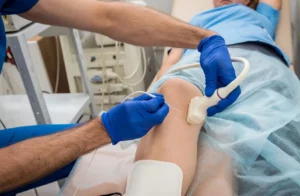Wearable health monitoring devices are tools designed to track and record a patient’s health information. They can be as simple as fitness trackers on an Apple Watch or as critical as blood sugar or blood pressure monitoring devices.
About 1 in 3 American adults use health monitoring devices in some capacity. The vast majority of users use the device for fitness purposes. However, 1 in 4 of those users need their wearable device for a medical reason.
This article will focus on wearable medical technology for individuals who require monitoring for medical reasons.
Why Wearable Medical Devices Are Important
Wearable medical devices play a crucial role in modern healthcare by providing continuous, real-time monitoring of patients’ health. This immediate feedback can be vital in managing chronic conditions, where timely intervention can make a significant difference.
These devices are also great for people who live far from hospitals or who have mobility issues. They let the patient live a normal life without frequent visits to healthcare facilities, while still allowing their healthcare providers to monitor their condition.
| What Else You Should Know About Wearable Devices in Healthcare |
Examples of Wearable Health Monitors
Wearable ECG Monitors
Wearable ECG monitors can continuously track heart rhythms and detect irregularities. Regular monitoring of these metrics is crucial for many people with various heart conditions. Research shows that providers can detect atrial fibrillation much more easily among users compared to non-users.
Continuous Glucose Monitors (CGMs)
CGMs track glucose levels in real-time throughout the day and night. They can alert the patient if their blood sugar is too high or too low. This is especially helpful for people with diabetes.
Posture Correctors
Posture correctors are wearable devices designed to support and encourage proper posture. They are particularly beneficial for individuals with chronic back pain, spinal conditions, or those who spend long hours seated. These devices track the wearer’s posture throughout the day and provide feedback or gentle reminders to adjust their position.
Wearable Biosensors
These are small patches that stick to a patient’s skin. They can monitor various physiological data points like temperature, respiratory rate, sleep patterns, heart rate, and movement. They will also send alerts to healthcare providers if the readings indicate a potential problem.
Wearable Defibrillators
Wearable defibrillators are used by people at risk of sudden cardiac arrest. They monitor heart rhythms and can automatically deliver a shock if a life-threatening heart rhythm is detected.
What Manufacturers Need to Know About Developing a Wearable Device
While creating a wearable health device, manufacturers need to consider several key factors to ensure the product is effective, reliable, and user-friendly.
Usability
Your device should be comfortable and easy to use in the patient’s daily life. For example, a wearable monitor must be water-resistant if it’s going to be worn in the shower. You should also aim to make the device as non-intrusive as possible.
Connectivity
Ensure the device can easily transfer data to healthcare providers. This might mean incorporating Wi-Fi, Bluetooth, or cellular connections. Reliable data transmission is crucial for real-time remote patient monitoring.
Battery Life
The device should have a long battery life to avoid frequent recharging. Long battery life is essential for continuous monitoring without interrupting the user’s daily activities.
Size & Design
The device must be small and discreet enough to wear or carry comfortably. It should also be designed to meet performance requirements without compromising its compact size.
Software Integrity
Software malfunctions can lead to device malfunctions, which can have serious implications for patient care. Ensure you perform rigorous software tests during your device development process to verify its integrity.
Data Accuracy
Since these devices provide critical health data, the information must be accurate and reliable. This is essential for healthcare providers to make informed decisions based on the data from the device. Use test data during development to ensure accuracy.
Regulatory Compliance
Wearable health devices must comply with FDA regulations. This means the device’s software and data must be verified and validated for accuracy and reliability before it can go onto the market.
The Development Process
The FDA will review not just the device, but also the process used to develop it. Ensure your development process includes proper risk management and that both the software and data have undergone thorough verification and validation. You will also need to provide detailed documentation showcasing your development process.
Create High-Quality Wearable Health Devices That Follow Best Practices
Developing wearable health devices is a complex task that requires precision and a deep understanding of both technology and healthcare needs. The key difficulty lies in meeting rigorous healthcare industry standards while ensuring the device is user-friendly.
Vantage MedTech offers a tailored approach to this task with our digital health service. We can enhance the development cycle of wearable medical devices by concentrating on user experiences, software integrity, and medical device compliance requirements. With our help, your device will be innovative, reliable, and market-ready.
Let’s discuss your idea and how we can turn it into reality.




